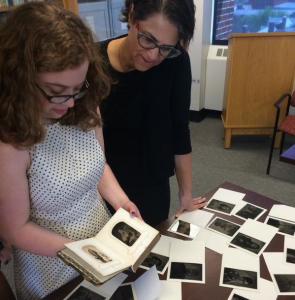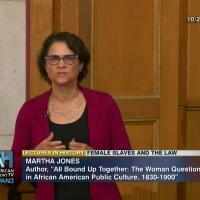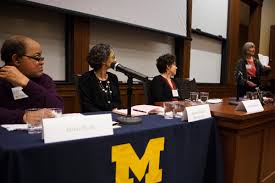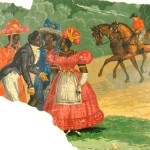What can we learn from two photo albums assembled by an African American woman and her family in the last decades of the nineteenth century? Filled with rich layers of family, community, and politics and set in the early years of Jim Crow, in Arabella Chapman’s albums we  find histories both intimate and epic. Black Americans, including Arabella’s family and neighbors, assembled their own images, through which they crafted counter-narratives that challenged a rising tide of racism. At the same time, in their images are a politics of pleasure. From careful sartorial choices of formal portraits to rare scenes of leisure, Chapman’s albums allow is to take an intimate glimpse into how black Americans embodied the lived pleasure of everyday life. Arabella Chapman’s albums have been carefully preserved at the University of Michigan’s William L. Clements Library. Once available only to library visitors, today this site makes these rare artifacts and the stories they tell available to broad audiences.
find histories both intimate and epic. Black Americans, including Arabella’s family and neighbors, assembled their own images, through which they crafted counter-narratives that challenged a rising tide of racism. At the same time, in their images are a politics of pleasure. From careful sartorial choices of formal portraits to rare scenes of leisure, Chapman’s albums allow is to take an intimate glimpse into how black Americans embodied the lived pleasure of everyday life. Arabella Chapman’s albums have been carefully preserved at the University of Michigan’s William L. Clements Library. Once available only to library visitors, today this site makes these rare artifacts and the stories they tell available to broad audiences.
The Celia Project
Along with William & Mary’s Hannah Rosen, I direct The Celia Project, a collaborative research project that is generating new scholarship on the history of sexual violence, women, and slavery in the United States through an exploration of the case of The State of Missouri v. Celia, A Slave (1856.) Celia’s case originally was brought to light by  historian Melton McLaurin’s 1991 book Celia, A Slave, published on the cusp of a new wave of scholarship on women and slavery; race, gender, and sexual violence; slavery and memory; and slavery and the law. The Celia Project brings together social, cultural, and legal historians with literary scholars to collectively produce new analyses of Celia and the multiple implications of the case. Our work was featured as part of CSPAN’s American History TV in winter 2014, in an episode of Lectures in American History on “Female Slaves and the Law.“
historian Melton McLaurin’s 1991 book Celia, A Slave, published on the cusp of a new wave of scholarship on women and slavery; race, gender, and sexual violence; slavery and memory; and slavery and the law. The Celia Project brings together social, cultural, and legal historians with literary scholars to collectively produce new analyses of Celia and the multiple implications of the case. Our work was featured as part of CSPAN’s American History TV in winter 2014, in an episode of Lectures in American History on “Female Slaves and the Law.“
Michigan Law Program in Race, Law & History
Since 2012, I have been co-director of the Michigan Law Program in Race, Law & History, with Bill Novak and Rebecca Scott. We are an interdisciplinary program dedicated to research and teaching at the intersection of these three lines of intellectual inquiry.  Through new scholarship, the training of students in law and history, and collaborations with colleagues and institutions at Michigan and beyond, the Program provides a unique historical perspective on the ongoing salience of race in our world. Our work includes curriculum development, a fellowship program, graduate student training, exhibitions, and public conferences.
Through new scholarship, the training of students in law and history, and collaborations with colleagues and institutions at Michigan and beyond, the Program provides a unique historical perspective on the ongoing salience of race in our world. Our work includes curriculum development, a fellowship program, graduate student training, exhibitions, and public conferences.
Le projet STARACO entend engager une réflexion historique pendant quatre ans sur la question des différences de statuts et de couleurs, sur la construction historique des “races” et des hiérarchies qui en ont découlé. Le thème de la construction des hiérarchies raciales dans l’expérience atlantique sera une façon de repenser à la fois l’histoire des relations entre l’Europe et les peuples du “Sud” et l’émergence des préjugés de couleur ou de “race” dont les effets marquent, aujourd’hui encore, les sociétés européennes.
In 2012-13, Proclaiming Emancipation examined the history of the Emancipation Proclamation through an exhibition, scholarly conference, public dialogue, and film. The project explored various perspectives on the proclamation and its meaning through the holdings of the William L. Clements Library, with select items from collaborating  institutions. Letters, sketchbooks, diaries, pamphlets, manuscripts, books, memoirs, prints, photographs, broadsides, and ephemera, all capture reflections upon the Proclamation and the meaning of emancipation. Lincoln’s order was more than formal terms outlined in a text. The Emancipation Proclamation took on full meaning as Americans on the home front, in slave quarters, on the battlefield, in contraband camps, and on the streets, wrestled with its ideas and its lived consequences. The exhibit, which I curated with Clayton Lewis, can be viewed here. And the papers from our scholars conference were published by the Journal of the Civil War Era, here.
institutions. Letters, sketchbooks, diaries, pamphlets, manuscripts, books, memoirs, prints, photographs, broadsides, and ephemera, all capture reflections upon the Proclamation and the meaning of emancipation. Lincoln’s order was more than formal terms outlined in a text. The Emancipation Proclamation took on full meaning as Americans on the home front, in slave quarters, on the battlefield, in contraband camps, and on the streets, wrestled with its ideas and its lived consequences. The exhibit, which I curated with Clayton Lewis, can be viewed here. And the papers from our scholars conference were published by the Journal of the Civil War Era, here.
Toward an Intellectual History of Black Women
 In 2010-12 I, along with Mia Bay, Farah Jasmine Griffin, and Barbara Savage directed Toward an Intellectual History of Black Women, sponsored in large part by the Columbia University Center for the Study of Social Difference. This research project was dedicated to recovering the history of black women as active intellectual subjects and to moving the study of black thought, culture, and leadership beyond the “Great Men” paradigm that characterizes most accounts of black intellectual activity. A collaborative effort designed to support the development of the next generation of scholars in this field, the project examines the perception and construction of black intellectual leadership as male and African-American women’s contributions to black thought, political mobilization, creative work and gender theory. In 2015, the project’s edited volume was published by the University of North Carolina Press.
In 2010-12 I, along with Mia Bay, Farah Jasmine Griffin, and Barbara Savage directed Toward an Intellectual History of Black Women, sponsored in large part by the Columbia University Center for the Study of Social Difference. This research project was dedicated to recovering the history of black women as active intellectual subjects and to moving the study of black thought, culture, and leadership beyond the “Great Men” paradigm that characterizes most accounts of black intellectual activity. A collaborative effort designed to support the development of the next generation of scholars in this field, the project examines the perception and construction of black intellectual leadership as male and African-American women’s contributions to black thought, political mobilization, creative work and gender theory. In 2015, the project’s edited volume was published by the University of North Carolina Press.
Reframing the Color Line: Race and the Visual Culture of the Atlantic World
In 2009-10 Clayton Lewis and I curated the exhibit “Reframing the Color Line: Race and the Visual Culture of the Atlantic World.” This exhibit examines the early constructions of race in visual culture and asks “what were the origins of racism’s visual vocabulary?” New answers emerge from an exploration of print collections, scholarship in cultural history, the history of art, and the trans-Atlantic context out of which early-American racism  appeared. Reframing the Color Line relationship between early anti-black images from the United States, which undergirded slavery and racism, to French and British images, which rationalized European nationalism and colonialism, we understand more fully how ideas in the United States were are part of global currents of thought. This perspective also offers critical vantage point on today’s visual vocabulary of race and difference.
appeared. Reframing the Color Line relationship between early anti-black images from the United States, which undergirded slavery and racism, to French and British images, which rationalized European nationalism and colonialism, we understand more fully how ideas in the United States were are part of global currents of thought. This perspective also offers critical vantage point on today’s visual vocabulary of race and difference.


